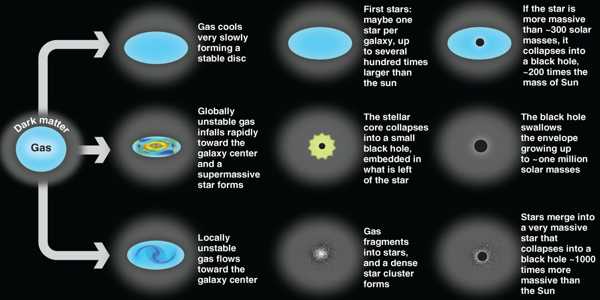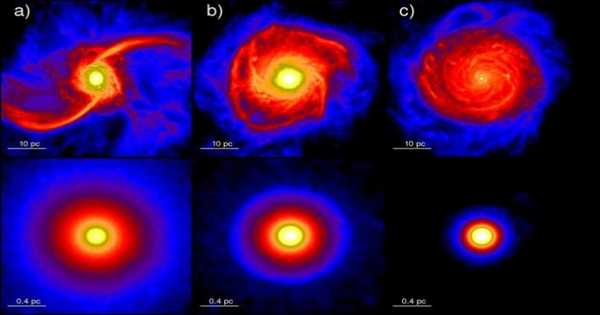Supermassive black holes, or SMBHs, are black holes with masses tens of millions to billions of times that of our sun. The Milky Way is home to an SMBH with a few million times the mass of the Sun. Surprisingly, astronomical observations show that SMBHs existed even when the universe was very young. A billion solar mass black holes, for example, were discovered when the universe was only 6 percent of its current age, 13.7 billion years. How did these SMBHs form in the early universe?
A team led by a theoretical physicist from the University of California, Riverside, has proposed an explanation: a massive seed black hole produced by the collapse of a dark matter halo. A dark matter halo is an invisible matter halo that surrounds a galaxy or cluster of galaxies. Despite the fact that dark matter has never been detected in a laboratory, physicists are confident that this mysterious matter, which accounts for 85 percent of the universe’s matter, exists. If a galaxy’s visible matter were not surrounded by a dark matter halo, it would fly apart.
“Physicists are puzzled as to why SMBHs in the early universe, which are located in the central regions of dark matter halos, grow so massively in such a short time,” said Hai-Bo Yu, an associate professor of physics and astronomy at UC Riverside and the study’s lead author.
“Imagine a 5-year-old child weighing 200 pounds. Such a child would astound us all because we are all aware of the average weight of a newborn baby and how quickly this baby can grow. When it comes to black holes, physicists have general expectations about the mass and growth rate of a seed black hole. The presence of SMBHs suggests these general expectations have been violated, requiring new knowledge. And that’s exciting.”
How do supermassive black holes in the early universe originate? A team led by a theoretical physicist has come up with an explanation: a massive seed black hole that the collapse of a dark matter halo could produce.
A seed black hole is a black hole in its early stages, similar to the baby stage in a human’s life. “There are two possibilities,” Yu added. “The seed – or ‘baby’ – black hole is either much more massive than we thought, or it is growing much faster than we thought, or both. The question then becomes, what are the physical mechanisms for creating a large enough seed black hole or achieving a fast enough growth rate?”
“It takes time for black holes to grow massive by accreting surrounding matter,” said co-author Yi-Ming Zhong, a postdoctoral researcher at the University of Chicago’s Kavli Institute for Cosmological Physics. “Our paper demonstrates that if dark matter has self-interactions, the gravothermal collapse of a halo can result in the formation of a massive enough seed black hole. Its growth rate would be more in line with market expectations.”
The collapse of pristine gas in protogalaxies in the early universe is a popular mechanism used to explain SMBHs in astrophysics. “However, unless the seed black hole experienced an extremely fast growth rate, this mechanism cannot produce a massive enough seed black hole to accommodate newly observed SMBHs,” Yu said. “Our findings offer an alternative explanation: a self-interacting dark matter halo undergoes gravothermal instability, and its central region collapses into a seed black hole.”

The explanation Yu and his colleagues propose works in the following way:
Under the influence of gravity, dark matter particles first cluster together to form a dark matter halo. During the halo’s evolution, two opposing forces — gravity and pressure — are at work. Dark matter particles are drawn inward by gravity, but pushed outward by pressure. If dark matter particles have no self-interactions, then as gravity pulls them toward the central halo, they become hotter, which means they move faster, the pressure effectively increases, and they bounce back. However, in the case of self-interacting dark matter, self-interactions of dark matter can transport heat from “hotter” particles to nearby colder ones. This makes it difficult for the dark matter particles to bounce back.
Yu explained that the central halo, which would eventually collapse into a black hole, has angular momentum, which means it rotates. Self-interactions can cause viscosity, or “friction,” which dissipates angular momentum. The central halo, which has a fixed mass, shrinks in radius and rotates slowly due to viscosity during the collapse process. As the central halo evolves, it eventually collapses into a single state: a seed black hole. This seed can grow in size by absorbing surrounding baryonic – or visible – matter, such as gas and stars.
“The advantage of our scenario is that the seed black hole’s mass can be large because it is produced by the collapse of a dark matter halo,” Yu explained. “As a result, it has the potential to grow into a supermassive black hole in a relatively short timescale.” The researchers’ new work is novel in that they identify the importance of baryons – ordinary atomic and molecular particles – for this concept to work.
“First, we show that the presence of baryons, such as gas and stars, can significantly accelerate the onset of a halo’s gravothermal collapse, and a seed black hole can be created early enough,” said Wei-Xiang Feng, Yu’s graduate student and paper co-author. “Second, we show that self-interactions can cause viscosity, which dissipates the central halo’s angular momentum remnant. Third, we devise a method for examining the condition for triggering general relativistic instability of the collapsed halo, which ensures the formation of a seed black hole if the condition is met.”
Yu has spent the last decade investigating novel predictions of dark matter self-interactions and their observational consequences. His research has demonstrated that self-interacting dark matter can explain the observed motion of stars and gas in galaxies.
“Stars and gas dominate the central regions of many galaxies,” he said. “As a result, it’s natural to wonder how the presence of this baryonic matter influences the collapse process. We demonstrate that it will hasten the onset of the collapse. This property is precisely what we require to explain the origin of supermassive black holes in the early universe. Self-interactions also cause viscosity, which can dissipate the angular momentum of the central halo and aid in the collapse process.”















